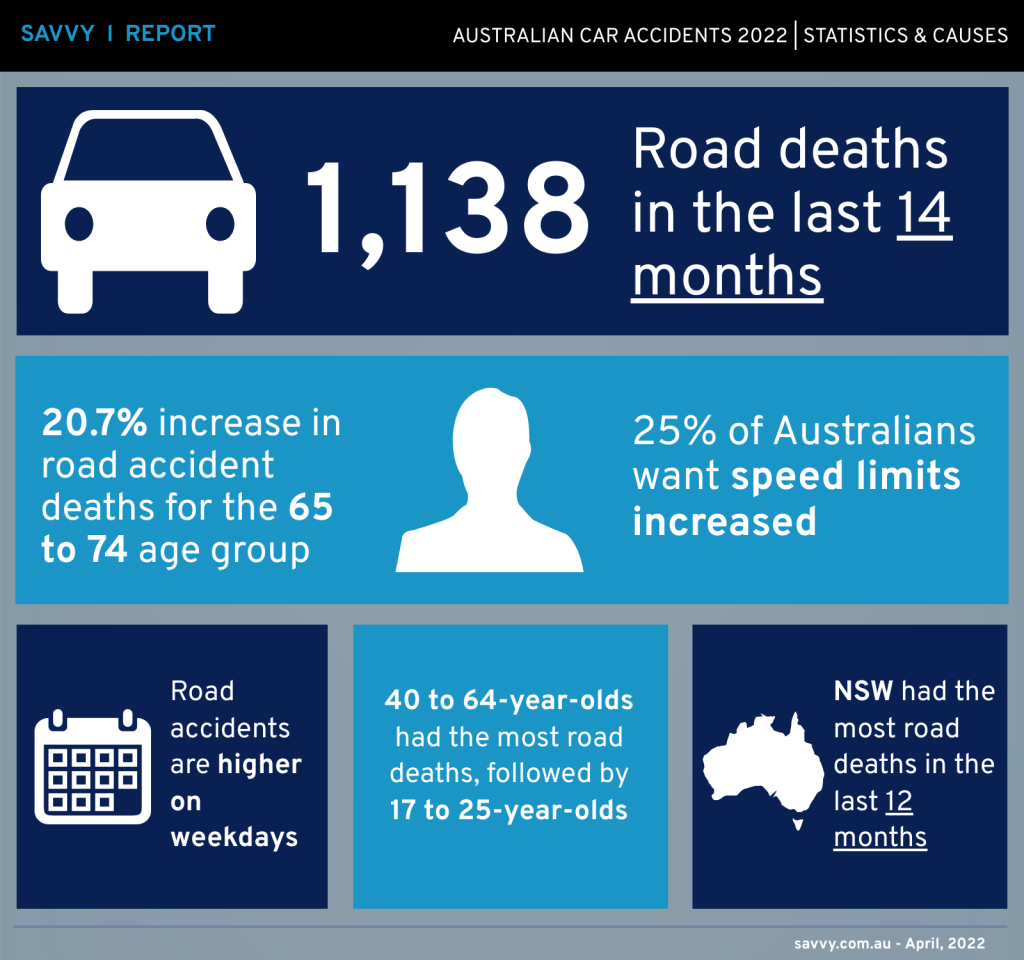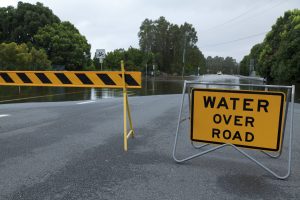
- The Savvy Promise
At Savvy, our mission is to empower you to make informed financial choices. While we maintain stringent editorial standards, this article may include mentions of products offered by our partners. Here’s how we generate income.
The Australian Government released some sobering news in April: road fatalities have spiked 2.7% in the last 12 months, the largest increase in incidents since 2018. More than 1,100 people have died in road accidents since February 2021. In this report, we analyse the latest statistics on fatal crashes, road injuries and what you can do to minimise your risk.
Savvy has found according to reports, more than 90% of Australian households currently have a car. In fact, there are more than 20 million registered vehicles on our roads. Transport is clearly a major component of our economy for personal and business use but unfortunately, thousands are impacted each year by transport-related industries.
- 1,138 road deaths in Australia over the last 14 months
- 2021 saw a total of 1,133 road fatalities
- There were 559 vehicle driver deaths, an increase from 545 the previous year
- Speeding still remains the top cause of accidents, followed by distracted and fatigued driving
- 15% decrease in road accident deaths for the 40 to 64 age group
- 7% increase for the 65 to 74 age group
- 17 to 25-year-olds are the second-highest age bracket impacted by road deaths
- Young men are more likely to be involved in a crash
- Road accidents are higher on weekdays

Statistics at a glance
Although there was a drop in the number of road deaths from 2018 to 2020, there has been an increase in casualties over the last two years. Now, a 4.4% annual fatality rate per 100,000 people is recorded. This is a spike of 2.4% compared to March last year.
The good news is, the average number of fatalities has dropped from 104 to 94.
It is no reason to get complacent on the roads though, with speeding still an issue and the top cause of fatal accidents in Australia. The posted speed limit is at its highest in two years with 140 drivers travelling at 110 or more kilometres per hour when they crashed.
In 2021, the number of vehicle driver deaths totalled 559. This figure is up from the previous year by six driver casualties. Motorcyclist fatalities totalled 229, passengers counted 179 and pedestrians recorded 126. Cyclists' casualties were 35.
The 40 to 64 age group had the most road accident deaths
There have been 367 road accident deaths in the 40 to 64-year-old age group. The type of accidents this age group are commonly involved in are nose-to-tail crashes and sideswipes.
The second-highest category of fatalities by age is 17 to 25, with a total of 223 deaths in 2022. This figure is followed by the age group of 26 to 39 (219 deaths), 75 and over (146 deaths), 65 to 74 (114 deaths) and 0 to 16 (61 deaths).
The 0 to 16 age group figure has not changed in the last year but increased from 45 fatalities in 2020 to 61 in 2021.
Car accidents are a top concern for over 70% of people aged 65+. While more than 58% of those aged between 35 and 44 are also most worried about car accidents, only 2.1% fear a train crash. In the 18 to 24 age bracket, 58.7% are concerned about the scenario of a car accident as well.
Men now make up just over two-thirds of serious injuries
In March last year, a total of 7,082 (67.3%) males were seriously injured as a result of a road accident, compared to 3,436 (32.7%) females.
In March 2022, the number of males who died from a crash was 858, a slight increase from 811 the previous year. On the other hand, female casualties have decreased from 292 to 277. It raises the question of whether gender makes a difference when it comes to road trauma.
Young drivers are often more at risk of fatal road accidents than other age groups. Despite the number of deaths between the 17 to 25 age group sitting less than 40 to 65-year-olds, many studies in Australia over the past 10 years confirm that young men have been involved in substantially more road crashes than young women.
Research suggests that this comes down to physiological, psychological and behavioural differences associated with age, which increases the risk-taking behaviours. However, because of the lack of neurological development and driving inexperience, this puts younger drivers more at risk.
From a gender perspective, young male drivers engage in more risk-taking than young women because of the biological maturity difference, various analyses prove. Over the years, MRI studies have shown the male brain doesn’t fully develop until 25, while the woman’s brain matures at 21.
Weekdays saw the most accidents, compared to weekends and evenings
Road accidents peak on weekdays between Monday at 6 am and Friday 5:59 pm. The current total is 655 fatal crashes, a steep increase from last year which recorded 588 casualties.
Surprisingly, weekends (405 deaths) and driving at night (421 deaths) recorded fewer fatal crashes than weekdays.
During the day, the most accidents occurred from March 2021 to March 2022 totalling 639 fatal crashes. 213 of these incidents recorded the driver travelling between 70 and 90km per hour, while 308 were driving between 50 and 60km per hour. There were 18 casualties as a result of travelling less than 40km.
New South Wales is the state with the most road deaths in Australia in the last 12 months
Fatal road accidents happen all across Australia with thousands impacted each year. New South Wales has been affected the most with 290 casualties over the last 12 months, up from 275 in the previous period. Currently, there have been 102 casualties this year. This figure has also increased from 83 casualties in 2021.
Of these 102 fatalities, 55 were drivers of a motor vehicle, while 13 were passengers. Motorcyclists made up 23 of the casualties.
Males were the most commonly impacted (76 deaths), with the number of females less than half at 26 deaths. 72 of these accidents were country of New South Wales and 30 in the metropolitan areas.
State-by-state incidents
In March, New South Wales also recorded the most fatal road accidents at 25, an increase from 2021 which reported 19. This was closely followed by Queensland (20 deaths), Victoria (18 deaths), Western Australia (15 deaths), South Australia (seven deaths), Tasmania (6 deaths) and the Northern Territory (three deaths).
The Australian Capital Territory did not record any fatalities on the road last month. In the last 12 months, however, three deaths have been reported.
New South Wales, Western Australia, Tasmania and the Northern Territory have all experienced a rise in fatal road accidents in the last 12 months. Victoria, Queensland and the Australian Capital Territory reported a slight decrease, while South Australia casualties have dropped by half from March 2021 to March 2022.
Although, within the first three months of 2022, Queensland documented 32 fatal road accidents, an increase of six deaths from last year. Queensland also had one of the highest rates of car theft nation wide. Police continue to issue warnings to road users for the state as the horrendous road toll climbs.
Speeding, distracted and fatigue-related crashes
Speeding, distracted and fatigued driving are the biggest killers on our roads.
Whether it’s travelling faster than the legal limit, using smartphones, eating or applying makeup while driving, or getting behind the wheel when you’re not adequately rested, drivers are still breaking the rules and not paying attention.
Young drivers are the top culprits for using their mobile phones while driving, leading to serious and tragic accidents. In particular, the 18 to 24 and 25 to 39 age groups reported the highest use of using mobile phones behind the wheel.
18 to 24-year-olds are twice as likely to receive a speeding fine as well. Despite speeding being the number one killer on our roads, 25% of Australians reported last year they would like to see the speed limits increase.
20% of Australians admit to driving tired at least once a week. Fatigued driving is caused by a few factors, including lack of quality sleep, extended periods of driving and/or overworked schedules.
“While speeding is the number one culprit leading to car accidents, the increase in fatalities over the last 12 months is also stimulated by distraction,” says CEO of Savvy Finance Bill Tsouvalas. More Australians are experiencing stress from the loss of jobs, financial troubles and lifestyle changes which are causing people to be more distracted behind the wheel. This, combined with a lack of quality sleep and not paying attention, is causing a high climb in road tolls, despite a decrease in the amount of traffic on the road due to lockdowns. Now, more than ever, drivers must ensure they have the right car insurance for their needs to help protect them against thousands of dollars worth of damage.”
Drive the safety message home
Avoid common road accidents and use these tips to stay safe:
- Do not forget the basics – obey the speed limit, drive the right speed for the weather and road conditions, stop at red lights, use your turn signals, yield the right away and wear seatbelts correctly
- Turn the engine off before using your phone or if tempted, switch over to aeroplane mode or use hands-free while driving – but remember, hands-free can still be a distraction
- Do not trust your tired self, turn to Uber or similar if you need a lift and feel fatigued
- Stay alert and keep calm behind the wheel
- Avoid common distractions such as eating/drinking, reading navigations, applying makeup/styling hair, smoking/vaping
- Take frequent breaks on extended drives
- Leave three to four seconds distance between you and the car in front to reduce the risk of a rear-end collision
- Undergo formal driving training
BITRE.gov.au - Road Deaths Australia - Feb 2022
BITRE.gov.au - Road Deaths Australia - March 2022
BITRE.gov.au - Road Deaths Australia - Monthly Bulletins
BITRE.gov.au - Fatal Road Crash Database
Statista.com - Statistics - Total Number of Road Deaths in Australia
Transport.NSW.gov.au - Statistics
RoadSafety.gov.au - Road Deaths by Age Group
Novusglass.com - The Dangers of Mobile Phone Usage While Driving
NRSPP.org.au - Road Trauma and Young Drivers - Does Gender Make a Difference
Did you find this page helpful?
This guide provides general information and does not consider your individual needs, finances or objectives. We do not make any recommendation or suggestion about which product is best for you based on your specific situation and we do not compare all companies in the market, or all products offered by all companies. It’s always important to consider whether professional financial, legal or taxation advice is appropriate for you before choosing or purchasing a financial product.
The content on our website is produced by experts in the field of finance and reviewed as part of our editorial guidelines. We endeavour to keep all information across our site updated with accurate information.









